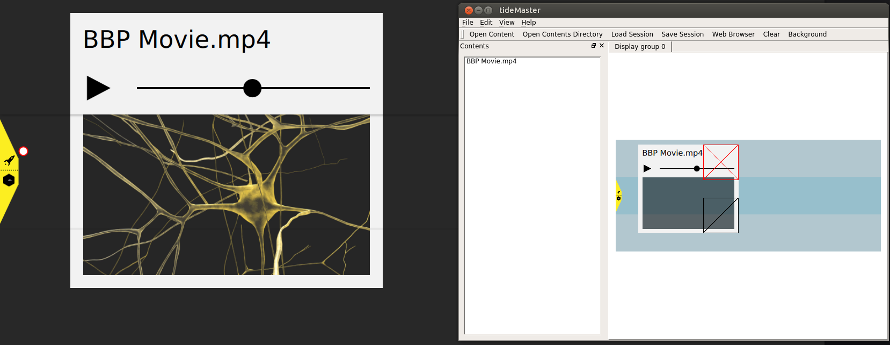Tide is BlueBrain's Tiled Interactive Display Environment. It provides multi-window, multi-user touch interaction on large surfaces - think of a giant collaborative wall-mounted tablet. See Tide in action in this youtube video.
Tide is a distributed application that can run on multiple machines to power display walls or projection systems of any size.
Its user interface is designed to offer an intuitive experience on touch walls. It works just as well on non touch-capable installations by using its web interface from any web browser.
Tide helps users with:
- Presenting and collaborating on a variety of media such as high-resolution images, movies and pdfs.
- Sharing multiple desktop or laptop screens using the DesktopStreamer application.
- Sketching new ideas by drawing on a whiteboard and browsing websites.
- Interacting with content streamed from remote sources such as high-performance visualisation machines through the Deflect protocol. In particular all Equalizer-based applications as well as Brayns ray-tracing engine have built-in support.
- Viewing high-resolution, immersive stereo 3D streams on compatible hardware.
Run 'tide' from the bin folder to start the application. By default it launches three wall processes in a horizonal layout. Content can be opened from the control user interface or by opening the web interface at http://localhost:8888.
On a touch wall, click the rocket icon on the left control bar to browse for contents and applications. Touch points are received via the TUIO protocol on port 1701. To simulate a touch interface, build and run the SimpleSimulator application or download any client from TUIO. On a smartphone, search for TuioPad app.
For more detailed information refer to the User Guide.
The application can be entirely controlled from the web interface or even using direct REST API calls. Simply drag and drop a file to upload it to the wall.
A pre-built Ubuntu 18.04 package is available from the releases page. Download it and install it with:
sudo apt install ./tide_1.5.0~bionic_amd64.deb
Please note that there are some stability issues with the system Qt packages affecting notably the web browser. We recommend installing Qt 5.9.7 from the official website. To use it, add the following to your .bashrc:
QT_HOME=/home/$USER/Qt5.9.7/5.9.7/gcc_64
export PATH=$QT_HOME/bin:$PATH
export LD_LIBRARY_PATH=$QT_HOME/lib:$LD_LIBRARY_PATH
export QML_IMPORT_PATH=$QT_HOME/qml
For other platforms, see next section for building from source.
Basic procedure on Linux / OSX:
git clone --recursive https://github.com/BlueBrain/Tide.git
mkdir Tide/build
cd Tide/build
cmake -GNinja -DCLONE_SUBPROJECTS=ON ..
ninja
The master branch always contains the latest development features; see Changelog. To build a stable release checkout its tag:
git checkout 1.5.0
Tide uses a set of common CMake modules to help with the configuration and handling of dependencies. To install required system packages on Ubuntu (apt-get) or OSX (macports) run:
cmake .. -DINSTALL_PACKAGES=ON
For detailed instructions on how to build Tide on a specific platform refer to Building Tide.
Tide is the direct successor of DisplayCluster at BlueBrain. Most of the code has been rewritten based on Qt's Qml2 engine and multithreaded operations for greatly optimized performance and stability.
It offers a modern alternative to Sage/Sage2 built on proven and efficient technologies (C++14, Qt5, MPI).
The full documentation is available at bluebrain.github.io
The development of this software was supported by funding to the Blue Brain Project, a research center of the École polytechnique fédérale de Lausanne (EPFL), from the Swiss government’s ETH Board of the Swiss Federal Institutes of Technology.
This project has received funding from the European Union's Horizon 2020 Framework Programme for Research and Innovation under the Specific Grant Agreement No. 720270 (Human Brain Project SGA1).
This project is based upon work supported by the King Abdullah University of Science and Technology (KAUST) Office of Sponsored Research (OSR) under Award No. OSR-2017-CRG6-3438.
Copyright (c) 2013-2022 Blue Brain Project/EPFL,
Copyright (c) 2013-2015 King Abdullah University of Science and Technology, Saudi Arabia
Copyright (c) 2011-2012 The University of Texas at Austin.
All rights reserved.
The views and conclusions contained in the software and documentation are those of the authors and should not be interpreted as representing official policies, either expressed or implied, of École polytechnique fédérale de Lausanne de Lausanne.



